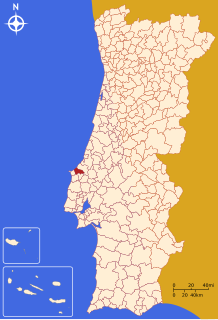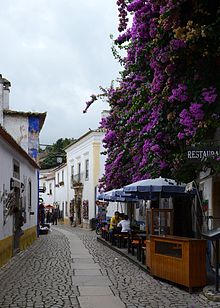Óbidos (Portuguese pronunciation: [ˈɔβiðuʃ]; Proto-Celtic: *Eburobrittium) is a town (Portuguese: vila) and a municipality in the Oeste Subregion in Portugal. The town proper has approximately 3100 inhabitants. The municipality population in 2011 was 11,772,[1] in an area of 141.55 square kilometres (54.65 square miles).[2]
Contents [hide]
1History
2Geography
3Tourism
3.1Óbidos Medieval Market
4See also
5References
6External links
https://en.wikipedia.org/wiki/%C3%93bidos,_Portugal
蔣勳
Obidos的城牆高大完整,走一圈,大概對古代城市的結構有具體了解。
例如,如果在清代,台北的北門、南門、西門、東門,用城牆連起來大概就是一個城市的尺度了吧⋯⋯
Obidos也差不多,在高約十公尺的城牆上走,可以看到四周保留完整的城牆,牆頭有步道,有箭垛,敵人來襲,不容易進攻。
人類的歷史往往因爲一個物質科技的出現就全然改變了,例如火藥槍炮,城市高大厚實的牆頃刻摧毀了,例如汽車、火車出現,城市的尺度也即刻改變了,步行、牛車或騎馬,清代的人很難想像今天台北的尺度空間吧?
我們改變了什麼?我們在快速改變中相信什麼?智慧型手機的出現,短短時間,人類有多麽根本的生活變化?
坐在城頭我做如是想⋯⋯


Óbidos | |
|---|---|
 A view of Óbidos | |
 | |
| Coordinates: 39°21′29″N 9°9′28″W | |
| Country | |
| Region | Oeste e Vale do Tejo |
| Intermunic. comm. | Oeste |
| District | Leiria |
| Parishes | 7 |
| Government | |
| • President | Humberto da Silva Marques (PPD-PSD) |
| Area | |
| • Total | 141.55 km2 (54.65 sq mi) |
| Elevation | 49 m (161 ft) |
| Highest elevation | 221 m (725 ft) |
| Lowest elevation | 0 m (0 ft) |
| Population (2015) | |
| • Total | 11,617 |
| • Density | 82/km2 (210/sq mi) |
| Time zone | UTC±00:00 (WET) |
| • Summer (DST) | UTC+01:00 (WEST) |
| Postal code | 2510 |
| Area code | 262 |
| Patron | Santa Maria |
| Website | www |
Óbidos (Portuguese pronunciation: [ˈɔβiðuʃ] ; Proto-Celtic: *Eburobrittium) is a town and a municipality in the Oeste region, historical province of Estremadura and the Leiria district. The town proper has approximately 3,100 inhabitants. The municipality population in 2011 was 11,772[1] covering an area of 141.55 square kilometres (54.65 square miles).[2]
History
[edit]


The name "Óbidos" is a Latinised (oppidum, citadel) derivation of the older Celtic "Eburobricio". The municipality grew from a Roman settlement near the foothills of an elevated escarpment. The region of Óbidos, extending from the Atlantic to the interior of Estremadura Province along the rivers and lakes has been inhabited since the late Paleolithic.[3] A settlement, constructed by early Celt tribes, was later a centre of trade for the Phoenicians.[3] Archeological evidence from the base of the medieval tower (south of Facho) at Óbidos Castle indicates Roman construction linked to an outpost of the Roman civitas of Eburobrittium, a large urban area that has been under excavation.[3] Archeological surveys determined the remains of a forum, baths and other Roman structures near the settlement.
After the fall of Rome, the region came under the influence of the Visigoths, although specific records are missing. The Roman town of Eburobrittium was abandoned in the 5th century for the more secure hilltop where today the principal settlement is located. Sometime after 713 the Moors established a fortification on this mountain, while a Christian community of Mozarabs lived in the Moncharro neighbourhood.
The city was taken from the Moors during the reign of the first King of Portugal, Afonso Henriques, in 1148. Tradition states that one knight, Gonçalo Mendes da Maia, was responsible for the successful storming of the Moorish castle.[3] The retaking of Óbidos was the final stage in the conquest of the Estremadura Province region, after the settlements of Santarém, Lisbon and Torres Vedras. Following the control of the region, the settlement received its first foral (charter) in 1195, during the reign of King Sancho I. In 1210, King Afonso II gave the title of this village to Queen Urraca. Since then, Óbidos has often been patronized by the Queens of Portugal, giving rise to its informal title as Vila das Rainhas (English: town of the Queens); several royal consorts enriched the village with donations from the Middle Ages until the 16th century.[3]
The castle and walls of Óbidos were remodelled during the reign of King Dinis I.[3] The limestone and marble structure was strengthened and elaborated, while the keep was created in the 14th century, by King Fernando. By the time of the first remodelling project, the settlement had also grown beyond the gates of the castle.
The Church of Santa Maria in Óbidos was the setting for the wedding of King Afonso V to his cousin, Princess Isabella of Coimbra, on 15 August 1441, when they were both still children aged 9 and 10, respectively.[3] Administrative reforms conducted by King Manuel I at Óbidos in 1513, included the institution of a formal charter and major requalification of the urban area.[3]
The 1755 earthquake caused damage to the village walls, a few churches, and many buildings, and resulted in the loss of architecture of Arab and Medieval inspiration.[3] Similarly, the Peninsular Wars were fought in the vicinity of Óbidos, including the Battle of Roliça.[3] More recently, the village was a centre of government and meeting place for those involved in the 1974 Carnation Revolution, linking it to the armed forces movement revolt.[3]
Geography
[edit]




沒有留言:
張貼留言